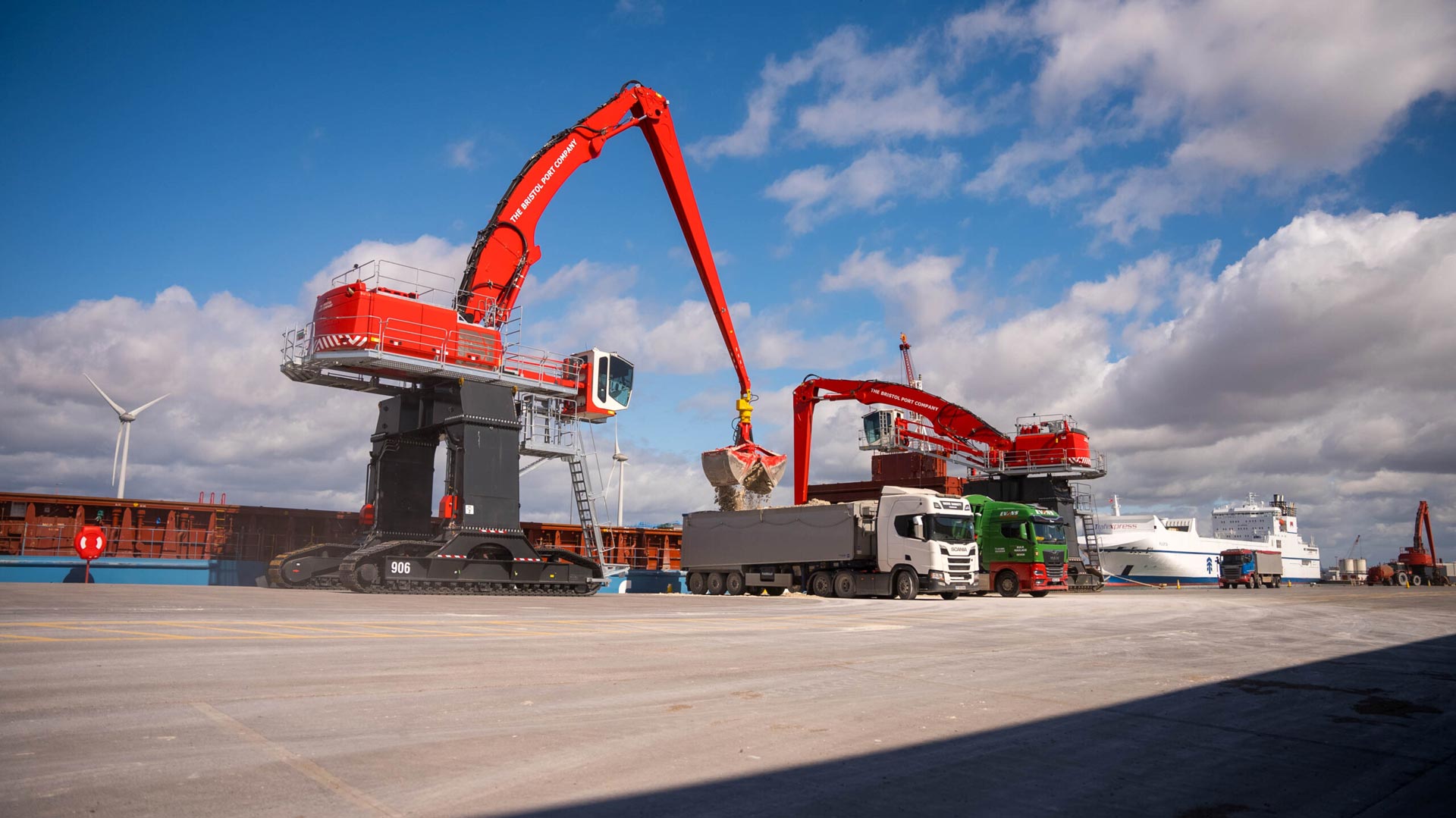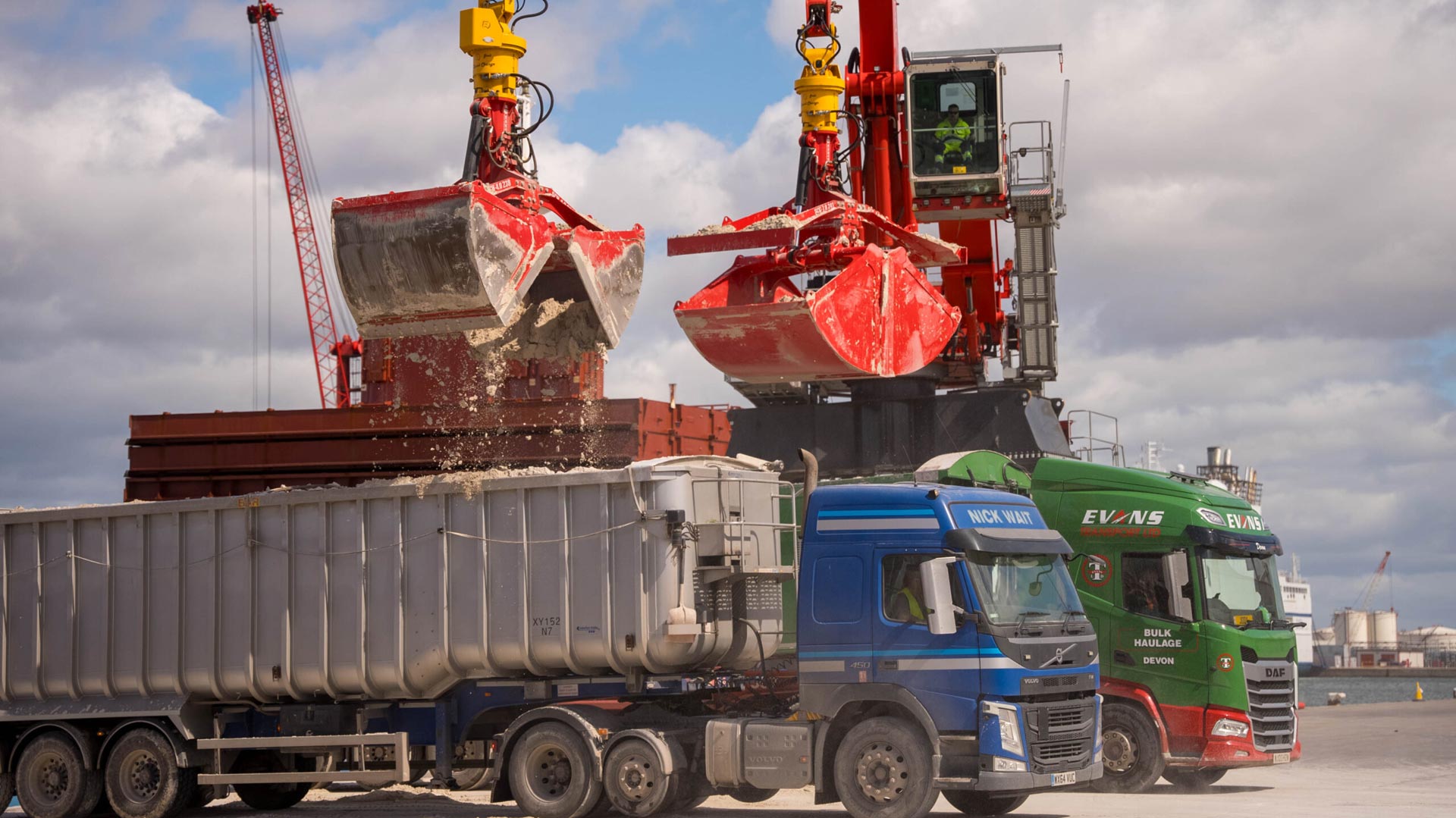Bristol Port Invest in two Sennebogen 870E’s
September 20, 2023
September 20, 2023
The Bristol Port Company was formed in 1991 when entrepreneurs Terence Mordaunt and David Ord purchased the Port of Bristol from Bristol City Council. Since the purchase, more than £600 million of private finance has been invested to create a modern, thriving business offering the full range of shipping, distribution and logistics services including dry bulk, fuels, break bulk and motor vehicles to name but a few.
Adding both the capacity and facilities to handle a variety of cargoes has also meant that additional material handling machinery has been required. “We have been operating a Sennebogen 830 material handler for several years to great effect.” Lucy Ellis, Bristol Port’s Project Engineer for Procurement commented. “This was sourced through the manufacturer’s previous dealer. Now that our close neighbours Molson Green are supplying them, they were at the top of our list to deal with.”
Since taking over the UK dealership for the Straubing manufactured material handlers and telehandlers, Molson have massively grown the German manufacturer’s market share to become their largest dealer throughout Europe.
The original 830E material handler was joined just nine months ago by the first of two 870E material handlers designed to maximise the capability of the docks. “We are limited with the size of vessels we can get in through the dock gates.” Lucy said. “This means that whilst we could put a larger machine on the dockside, it would be too large for the vessels we handle. We also must keep a close watch on the imposed loading of the quayside, something that the Sennebogen machines meet with spare capacity.”
Sennebogen manufacture their huge range of material handlers at two factories in Straubing, an hour east of Munich. Founded in 1952, the company manufactures a range of crawler, wheeled and rail mounted material handlers, crawler high reach demolition machines and a range of crawler and wheeled cranes and draglines. Forays into excavators for earthmoving came and went with Erich Sennebogen saying ‘We decided to concentrate on a smaller range of machinery. Equipment that we know we are very good at designing, building and supporting.’ The ‘smaller range’ includes the World’s largest material handler, the huge 895E Hybrid with operating weights starting at 420 tonnes.
The two 870E material handlers have been added to the fleet to minimise the time a vessel stays in port. “We have to be as efficient as possible when it comes to unloading vessels.” Lucy explained. “Not only will we be charged demurrage costs for delaying a vessel leaving, but with the Sennebogens mainly handling dry goods, we need to make sure we can empty a vessel whilst it’s dry. It can be a frustrating part of the working day when a vessel keeps having to close their hatches to ensure a cargo stays as dry as possible.”
At the time of our visit the pair of 870E material handlers were busy working alongside each other transferring a cargo of gypsum from the Netherlands into a fleet of artic and eight-wheeler tippers. Once unloaded, the material is run around the huge site to the storage area for this material.
Whilst there are large models in the Sennebogen range, the 870E Hybrid is by no means a lightweight. Tipping the scales at over 110 tonnes, the material handler has been specified with the manufacturer’s gantry undercarriage option. Built around a pair of 8.5m long track frames, each shod with 72 flat, cast steel pads. The huge, box section gantry frame forms a tunnel with a clear opening of 3.65m wide x 5.3m high allowing standard road trucks to pass through easily. The gantry massively reduces the time taken to load vessels as the cargo on each truck is always in the right position to be unloaded and the swing time and distance to the vessel is reduced to a minimum. Whilst Bristol Port is lucky enough to have ample space at its berths, the gantry undercarriage is ideally suited to ports where there is limited vehicle access. With the upper structure sitting so far from ground level, the remote fuel filling point makes refuelling the machine an easy and safe job from ground level. As the machine also requires a regular dose of AdBlue, Molson and Sennebogen were also able to have this refilling point situated remotely on the leg of the gantry allowing for safe and easy filling.
With the upper structure situated over 7m off the ground, access for the operator is still made easy thanks to a set of galvanised steps and ladders situated on one of the gantry frames. The initial ladder leads to a platform where the operator can lift a flap in the floor of the wide walkway surrounding the upper structure and climb up the last few steps. Once on this walkway, access to the entire upper structure, cab and engine bay is a simple affair. The large doors covering the engine, hydraulics and cooling system can all open easily allowing simple access within and should any components require changing, a built-in winch can lift and lower them in total safety.
Sennebogen offer two cab styles on their larger material handlers, the Maxcab and Mastercab with the latter chosen for both of the 870E Hybrids at Bristol. Thanks to the Mastercab being almost entirely glazed, the views from the seat are unrivalled. Sitting at over 12m off the ground, the operators are able to get a clear and unobstructed view into the hold of almost every vessel handled at the berth.
With the ever-increasing cost of fuel, Bristol Ports looked at the possibility of purchasing fully electric versions of the material handlers. Making enquiries with their utility providers, the cost of putting in a dedicated service to supply both machines was deemed far too costly at this moment in time. “We will keep on looking for the most environmentally friendly solutions each and every time we add to the fleet.” Lucy explained. “Unfortunately, the electric option wasn’t the right one for us this time. We do however believe we have a very efficient and environmentally friendly material handler in the 870E Hybrid.” The huge material handler is powered by a 261kW, StageV, Cummins B12 diesel engine which in turn powers the hydraulic system for the machine comprising a pair of 475 and a single 275 litre per minute pumps. The Hybrid part of the material handler’s name comes from its Energy Recovery System. This system uses the lowering of the boom to compress the gas contained in the nitrogen piston accumulator mounted in the rear of the machine’s upper structure. This stored energy is released when the operator lifts the boom again reducing the requirement for the engine to work as hard as a standard machine.
The business end of the machine includes a 13.5m ‘banana’ boom and 12.3m grab stick on both machines with the end of each stick fitted with an Exstel EXB-QC quick coupler allowing for rapid attachment changeover. “With the majority of our operations centred around dry bulk goods, we have both 4 and 7m3 Exstel clamshells for the machines, swapping them over depending on the material density.” Lucy commented. “Having the quick coupler futureproofs us as cargoes change and we are required to changeover attachments.”
Both Bristol Ports Company and Molson Group share a close working relationship, not only due to their proximity to each other, but also in the fact that both companies are heavily involved in supporting the local communities around Bristol and Avonmouth. “We have forged a good relationship with Molson over the past couple of years.” Lucy commented. “They are very open to comments and discussions over their products and are very accommodating when we have suggested changes that we wanted for the new material handlers. The service and back up we have had from them since they took over the Sennebogen dealership has been excellent, hence the reason we have returned to them for our latest purchase.”




